SKF轴承知识大全
SKF轴承命名方法
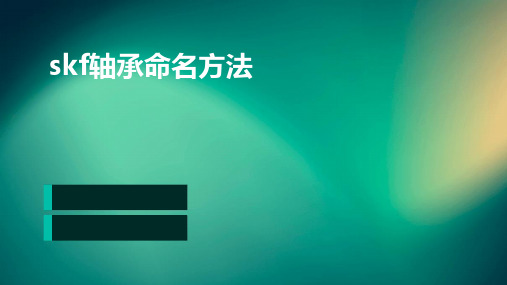
外径尺寸与公差
总结词
SKF轴承的外径尺寸通常以字母"d"后跟一个或两个数字表示,例如"d10"。公差则根据轴承的类型和 尺寸的不同而有所差异。
详细描述
外径尺寸是轴承的另一个重要参数,它决定了轴承在轴上的安装范围。外径尺寸通常以字母"d"后跟 一个或两个数字表示,例如"d10"表示外径为10毫米。公差则是外径的实际尺寸范围,它同样决定了 轴承的精度和配合性质。根据轴承的类型和尺寸的不同,公差的范围也会有所不同。
skf轴承命名方法
contents
目录
• SKF轴承基本知识 • SKF轴承型号命名规则 • SKF轴承尺寸与公差 • SKF轴承性能与特性 • SKF轴承应用领域 • SKF轴承维护与保养
01 SKF轴承基本知识
SKF轴承简介
01
瑞典SKF轴承公司成立于1897年 ,是全球最大的轴承制造商之一 ,提供各种类型的轴承和轴承单 元,广泛应用于工业领域。
宽度尺寸与公差
总结词
SKF轴承的宽度尺寸通常以字母"B"后跟 一个或两个数字表示,例如"B10"。公差 则根据轴承的类型和尺寸的不同而有所 差异。
VS
详细描述
宽度尺寸是轴承的一个重要参数,它决定 了轴承的承载能力和稳定性。宽度尺寸通 常以字母"B"后跟一个或两个数字表示, 例如"B10"表示宽度为10毫米。公差则是 宽度的实际尺寸范围,它同样决定了轴承 的精度和配合性质。根据轴承的类型和尺 寸的不同,公差的范围也会有所不同。
SKF轴承在航空领域的应用主要涉及到飞机发动机、传动系统等部位。在这些部位中,SKF轴承需要承受高转速和高温等恶劣 环境,同时还需要具备高精度和长寿命等特点。为了满足这些需求,SKF轴承采用了先进的材料和制造工艺,确保其产品质量 和性能达到航空工业的标准。
SKF轴承资料

远古时代的轴承
古代轴承的复原图
轴承的变革
1907
1919
1939
1972
1995
1900
1950
2000
轴承的基本功能
• 传递负荷 • 辅助作用
– 轴支撑 – 轴定位
轴承负荷
径向负荷
联合负荷
轴向负荷
轴承的工作原理
(书与桌实验)
直尺
铅笔
轴承的工作原理 (书与桌实验)
硬度 HRC
59 到 63 58 到 62 57 到 61 56 到 60 54 到 58 50 到 54
硬化过程:硬化效果
马氏硬化 贝氏硬化 钢化
表面硬化
标准应用 标准轴承
重型负荷轴承 球面滚子轴承
超重型负荷轴承 (+ 冲击负荷) 大型轴承
特殊应用 带有配合游隙的轴承(轧钢机)
特殊应用 轮毂单元、旋转环
• 一百万次运转除以33-1/3转数每分钟 = 30000 分钟 = 500 小时
• 这可为合格寿命:50周每周10小时或更少 就是500小时
– 符合一年的担保要求
计算轴承寿命
L10 = (C/P)p
p = 3 or 10/3
3用于球轴承
10/3用于滚子轴承
计算轴承寿命
L10h = 106 x (C/P)p
–
6005-Z 6205-Z 6305-Z
6006-Z 6206-Z 6306-Z
6007-Z 6207-Z 6307-Z
6008-Z 6208-Z 6308-Z
6009-Z 6209-Z 6309-Z
6005-2Z 6205-2Z 6305-2Z
SKF轴承知识大全

SKF轴承知识大全SKF轴承简介,SKF轴承型号的含义,NSK 公司概述,SKF轴承故障排除and so on.1:SKF轴承简介:SKF的全称是“Svenska Kullager-Fabriken”中文音译名称为“斯凯孚”;SKF集团总部设立于瑞典哥特堡,是轴承科技与制造的领导者。
Sven Wingquist在1905年发明了双列自动对心滚珠轴承,随即于1907年创立Svenska Kullargerfabriken瑞典滚珠轴承制造公司,简称SKF,生产企业:105家;员工人数:约38,748人;公司数量:约150家;2007年全年净销售额为585.59亿瑞典克朗;总裁兼首席执行官CEO:汤母·强斯顿Tom Johnstone公司之业务即以这种机械工程史上划时代的发明为起点而蒸蒸日上。
时至今年已届满一百周年,SKF仍秉持既定宗旨,不断发展,服务世界。
SKF执世界滚动轴承业之牛耳,经营的触角已遍及全球,业务遍及世界130个国家,每年生产五亿多个轴承,销售网遍布全球。
目前拥有200家分公司、80家制造厂、41000位员工和8000家代理商和经销商。
SKF亦生产及销售轴承钢及其他高品质特殊钢。
此外,SKF集团亦持续致力于轴承工业的研究与发展,平均每两天就有一项新的专利问世。
SKF集团也是第一家通过ISO14001环保认证的轴承公司,此项认证涵盖17个国家共60多个制造单位。
2:SKF轴承型号的含义SKF公司的滚动轴承,滚动轴承部件及附件的完整代号由基本代号和补充代号组成。
基本代号由轴承类型代号,尺寸系列代号和内径代号构成。
表示轴承的基本类型,结构和尺寸,是轴承代号的基础。
补充代号是轴承结构形状,尺寸,公差,技术要求有改变时在基本代号左右添加的代号。
在基本代号左边添加的代号为前置代号,用以识别轴承部件,在基本代号右边添加的代号为后置代号,用以表示与原设计有区别或与现行生产的标准有差异的设计问题。
skf轴承基础

滑动而造成轴承的损坏
提高刚性、降低噪声、提高轴引导的精度、补偿在
运行中的磨损、延长工作寿命。
2023年03月
返回
轴承失效缘由统计:
34%2023年03月16% 16%34%
安装不当 污染 润滑不当 疲劳
返回
油加热法的缺点: 1、温度把握不准确; 2、轴承简洁过热; 3、轴承极易被污染; 4、耗时长; 5、影响四周环境。
2023年03月
2、查出轴承径向游隙的削减量; 3、1-2=△; 七、装轴承的程序:
1、生疏图纸; 2、确认方法;
3、清洁轴承的安装现场; 4、领用轴承和工具,清洁; 5、测量轴颈数据〔至少9个点〕; 6、将轴承从盒里取出〔清洁内圈〕;
2023年03月
7、在轴颈上滴几滴清洁的淅油; 8、依据确认的方法安装; 9、测出安装后轴承的相关数据; 10、试转:轴承的惯性越大越好; 11、润滑:淅油润滑
2023年03月
五、轴承安装与拆卸的方法与工具
机械法〔小型〕 液压法〔中、大型〕 加热法〔多数〕
油加热有缺点
类型
大小
圆柱轴
圆锥轴
小型
冷安装(TMFT33) 锁紧螺母
(d<80mm) 拉拔器
冲击
加热器
中型
拉拔器
液压螺母
(80-200mm) 加热器
大型
拉拔器
液压螺母
(d>200mm) 加热器
2023年03月
2023年03月
安装工具:HN、TMFN系列
2023年03月
加热板:
2023年03月
72659c
加热器:
TIH 070m
skf轴承手册
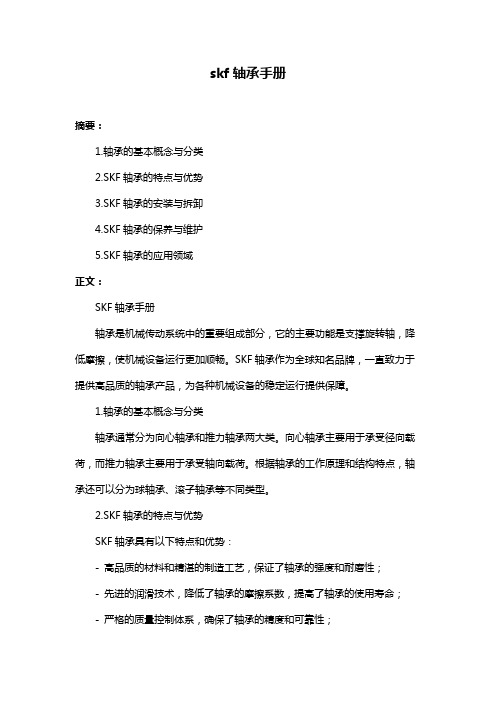
skf轴承手册摘要:1.轴承的基本概念与分类2.SKF轴承的特点与优势3.SKF轴承的安装与拆卸4.SKF轴承的保养与维护5.SKF轴承的应用领域正文:SKF轴承手册轴承是机械传动系统中的重要组成部分,它的主要功能是支撑旋转轴,降低摩擦,使机械设备运行更加顺畅。
SKF轴承作为全球知名品牌,一直致力于提供高品质的轴承产品,为各种机械设备的稳定运行提供保障。
1.轴承的基本概念与分类轴承通常分为向心轴承和推力轴承两大类。
向心轴承主要用于承受径向载荷,而推力轴承主要用于承受轴向载荷。
根据轴承的工作原理和结构特点,轴承还可以分为球轴承、滚子轴承等不同类型。
2.SKF轴承的特点与优势SKF轴承具有以下特点和优势:- 高品质的材料和精湛的制造工艺,保证了轴承的强度和耐磨性;- 先进的润滑技术,降低了轴承的摩擦系数,提高了轴承的使用寿命;- 严格的质量控制体系,确保了轴承的精度和可靠性;- 广泛的产品线,满足不同行业和设备的需求。
3.SKF轴承的安装与拆卸轴承的安装应遵循以下步骤:- 检查轴承和轴颈的尺寸、形状和表面质量,确保它们符合安装要求;- 清洗轴承和轴颈,去除污垢和毛刺;- 涂抹适量的润滑剂,降低安装过程中的摩擦;- 按照安装顺序和方向,将轴承安装到轴颈上;- 固定轴承,确保其位置准确;- 检查轴承的旋转是否顺畅,如有异常应立即停机检查。
拆卸轴承时,应按照相反的顺序进行,并注意保护轴承的表面质量和配合尺寸。
4.SKF轴承的保养与维护轴承的保养和维护对保证其正常运行至关重要。
以下是一些建议:- 定期检查轴承的润滑情况,确保润滑剂充足且质量良好;- 定期清洗轴承,清除污垢和磨损颗粒;- 定期检查轴承的运行状态,如发现异常声音、振动或发热等现象,应立即停机检查;- 避免轴承在过载、过热或灰尘多的环境下工作,以免影响其使用寿命。
5.SKF轴承的应用领域SKF轴承广泛应用于各种行业和设备,如汽车、机床、风电、航空航天、工程机械等。
skf 轴承手册
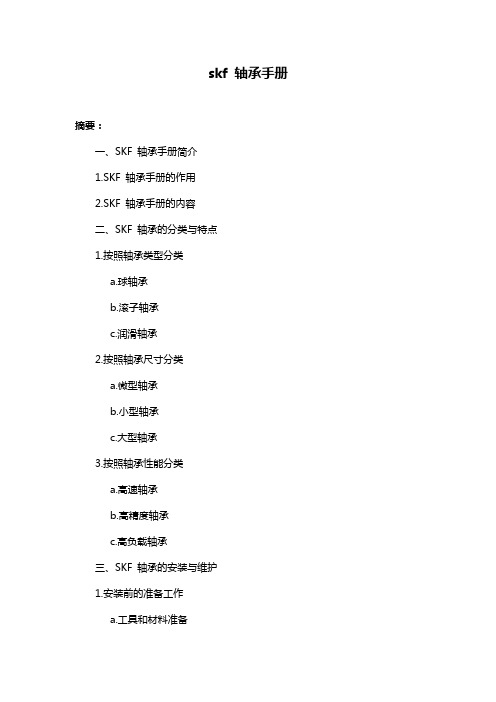
skf 轴承手册摘要:一、SKF 轴承手册简介1.SKF 轴承手册的作用2.SKF 轴承手册的内容二、SKF 轴承的分类与特点1.按照轴承类型分类a.球轴承b.滚子轴承c.润滑轴承2.按照轴承尺寸分类a.微型轴承b.小型轴承c.大型轴承3.按照轴承性能分类a.高速轴承b.高精度轴承c.高负载轴承三、SKF 轴承的安装与维护1.安装前的准备工作a.工具和材料准备b.轴承的检查与清洗2.轴承的安装方法a.球轴承的安装b.滚子轴承的安装c.润滑轴承的安装3.轴承的维护与保养a.轴承的润滑b.轴承的清洁c.轴承的检查与更换四、SKF 轴承的应用领域1.工业领域a.机床b.汽车c.航空航天2.医疗领域a.医疗设备b.生物医学工程c.牙科设备3.日常生活领域a.家电b.运动器材c.办公设备正文:【SKF 轴承手册简介】SKF 轴承手册是一本详细介绍SKF 轴承产品和相关技术的专业书籍。
它为工程技术人员提供了SKF 轴承的详细信息,包括轴承类型、尺寸、性能以及安装与维护等方面的知识。
SKF 轴承手册在轴承选型、安装和维护等方面具有很高的参考价值。
【SKF 轴承的分类与特点】SKF 轴承按照轴承类型分为球轴承、滚子轴承和润滑轴承;按照轴承尺寸分为微型轴承、小型轴承和大型轴承;按照轴承性能分为高速轴承、高精度轴承和高负载轴承。
SKF 轴承在各种类型和尺寸方面都具有优异的性能,可以满足不同工况和应用领域的需求。
【SKF 轴承的安装与维护】在安装SKF 轴承之前,需要做好充分的准备工作,包括工具和材料的准备以及轴承的检查和清洗。
轴承的安装方法有球轴承的安装、滚子轴承的安装和润滑轴承的安装等。
在轴承的使用过程中,需要做好维护与保养工作,包括轴承的润滑、清洁、检查和更换等。
正确的安装和维护可以确保轴承的性能和寿命。
【SKF 轴承的应用领域】SKF 轴承广泛应用于工业、医疗和日常生活等领域。
在工业领域,SKF 轴承可以应用于机床、汽车、航空航天等设备;在医疗领域,SKF 轴承可以应用于医疗设备、生物医学工程和牙科设备等;在日常生活领域,SKF 轴承可以应用于家电、运动器材和办公设备等。
SKF内部轴承基础培训
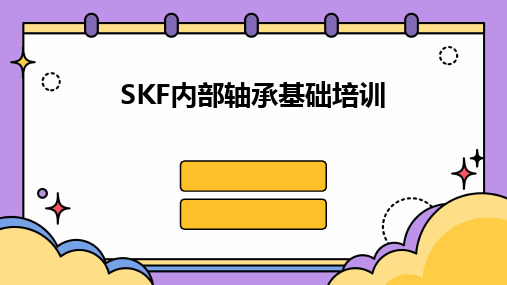
行业发展趋势分析
智能化发展
随着工业4.0的推进,轴承行业将更加注重 智能化发展,包括智能设计、智能制造、
智能维护等。
绿色环保
环保意识的提高将推动轴承行业向绿色环 保方向发展,如采用环保材料、优化生产
工艺等。
高性能化
06
总结回顾与展望未来发展 趋势
关键知识点总结回顾
轴承基本概念与分类 包括滚动轴承、滑动轴承等,以及各自
的特点和应用范围。
轴承性能参数与选用 讲解了轴承的主要性能参数如载荷、 转速、精度等,以及如何根据实际需
求选用合适的轴承。
轴承材料与制造工艺 介绍了轴承常用材料如钢、陶瓷等, 以及制造工艺如热处理、精密加工等。
采用特殊材料和工艺,可在高温 环境下长期稳定运行,适用于冶 金、陶瓷等高温行业。
密封件
采用优质材料和先进设计,可有 效防止润滑脂泄漏和外部污染物
侵入,提高轴承使用寿命。
03
轴承选型与安装技巧
选型依据及步骤
载荷类型和大小
根据轴承所受载荷的 类型(径向、轴向或 联合载荷)和大小, 选择合适的轴承类型 和尺寸。
SKF超精密轴承技术
通过优化设计和制造工艺,提高轴承的精度和稳定性,满足高端装备 的需求。
SKF环保型轴承技术
采用环保材料和特殊表面处理工艺,降低轴承对环境的影响。
SKF个性化定制服务
根据客户的特殊需求,提供从设计到制造的全方位个性化定制服务。
THANKS
感谢观看
SKF内部轴承基础培训
contents
目录
• 轴承基本概念与原理 • SKF轴承产品介绍 • 轴承选型与安装技巧 • 轴承维护与保养策略 • SKF轴承在各行业应用案例分享 • 总结回顾与展望未来发展趋势
skf轴承讲解
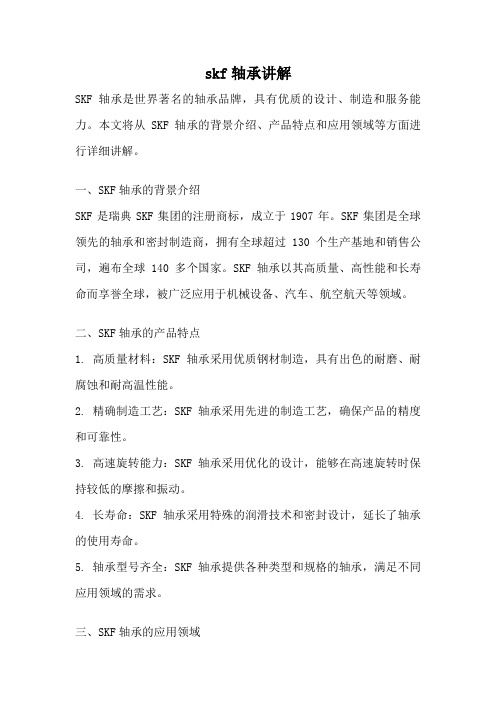
skf轴承讲解SKF轴承是世界著名的轴承品牌,具有优质的设计、制造和服务能力。
本文将从SKF轴承的背景介绍、产品特点和应用领域等方面进行详细讲解。
一、SKF轴承的背景介绍SKF是瑞典SKF集团的注册商标,成立于1907年。
SKF集团是全球领先的轴承和密封制造商,拥有全球超过130个生产基地和销售公司,遍布全球140多个国家。
SKF轴承以其高质量、高性能和长寿命而享誉全球,被广泛应用于机械设备、汽车、航空航天等领域。
二、SKF轴承的产品特点1. 高质量材料:SKF轴承采用优质钢材制造,具有出色的耐磨、耐腐蚀和耐高温性能。
2. 精确制造工艺:SKF轴承采用先进的制造工艺,确保产品的精度和可靠性。
3. 高速旋转能力:SKF轴承采用优化的设计,能够在高速旋转时保持较低的摩擦和振动。
4. 长寿命:SKF轴承采用特殊的润滑技术和密封设计,延长了轴承的使用寿命。
5. 轴承型号齐全:SKF轴承提供各种类型和规格的轴承,满足不同应用领域的需求。
三、SKF轴承的应用领域1. 机械设备:SKF轴承广泛应用于各类机械设备,如电动机、风力发电机、水泵、机床等。
其高质量和可靠性能确保了机械设备的正常运行和长寿命。
2. 汽车工业:SKF轴承在汽车发动机、变速器、悬挂系统等部位得到广泛应用。
其高速旋转能力和长寿命特点使汽车在高速行驶时具有更好的稳定性和可靠性。
3. 航空航天:SKF轴承在航空航天领域的应用也非常广泛。
其轻量化、高速旋转和耐高温等特点使得飞机、卫星等航空器具有更高的性能和可靠性。
4. 钢铁工业:SKF轴承在钢铁工业中的连铸机、轧机等设备中得到广泛应用。
其高负荷能力和耐磨性能保证了设备的正常运行和高效生产。
SKF轴承作为全球著名的轴承品牌,凭借其高质量、高性能和长寿命的特点,在机械设备、汽车、航空航天等领域得到广泛应用。
无论是在普通家用电器中还是在高速列车、飞机等高强度工程设备中,SKF轴承都发挥着重要作用,为各行各业的发展提供了可靠的支持。
SKF轴承知识大全
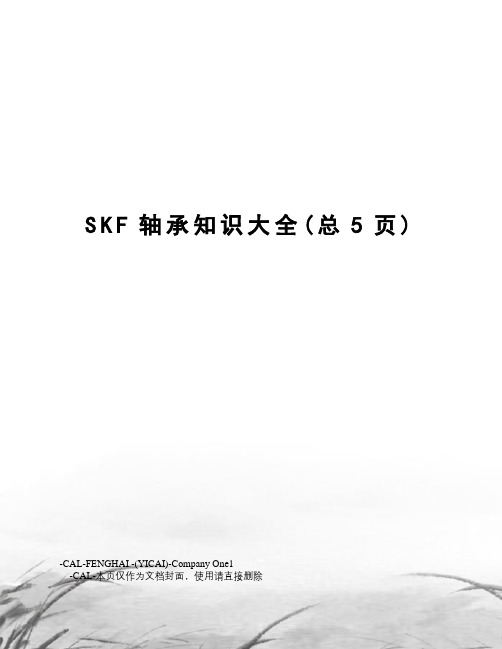
S K F轴承知识大全(总5页) -CAL-FENGHAI.-(YICAI)-Company One1-CAL-本页仅作为文档封面,使用请直接删除SKF 轴承知识大全SKF 轴承简介,SKF 轴承型号的含义,NSK 公司概述,SKF 轴承故障排除 and so on.1:SKF 轴承简介:SKF 的全称是“Svenska Kullager-Fabriken”中文音译名称为“斯凯孚”;2:SKF 轴承型号的含义SKF 公司的滚动轴承,滚动轴承部件及附件的完整代号由基本代号和补充代号组成。
基本代号由轴承类型代号,尺寸系列代号和内径代号构成。
表示轴承的基本类型,结构和尺寸,是轴承代号的基础。
补充代号是轴承结构形状,尺寸,公差,技术要求有改变时在基本代号左右添加的代号。
在基本代号左边添加的代号为前置代号,用以识别轴承部件,在基本代号右边添加的代号为后置代号,用以表示与原设计有区别或与现行生产的标准有差异的设计问题。
1)前置代号GS——推力圆柱滚子,推力滚针轴承座圈。
例:GS81107-推力圆柱滚子轴承81107 的座圈。
K——推力滚子和保持架的组合件里。
例:K81170。
K-——符合 AFBMA 标准系列英制圆锥滚子轴承带滚子和保持架组件的内圈(内锥体)或外圈(锥环)。
例:K-09067——系列为 09000 的圆锥滚子轴承的内锥体。
L——分离型轴承的单一内圈或外圈。
例:LNU207——圆柱滚子轴承 NU207 的内圈。
L30207——圆锥滚子轴承 30207 的外圈。
R——除去单一内圈或外圈的分离型轴承。
例:RNU207——圆柱滚子轴承 NU207 带滚子和保持架组合件的外圈。
R30207——圆锥滚子轴承和保持架组件的内圈。
WS——推力圆柱滚子,推力滚针轴圈。
例:WS81107——推力圆柱滚子轴承81107 的轴圈。
2.后置代号如果轴承代号中有数个后置代号,则这些后置代号按以下顺序分组排列:(1)内部设计,(2)外部设计,(3)保持架,(4)其他特点。
skf轴承手册 (2)
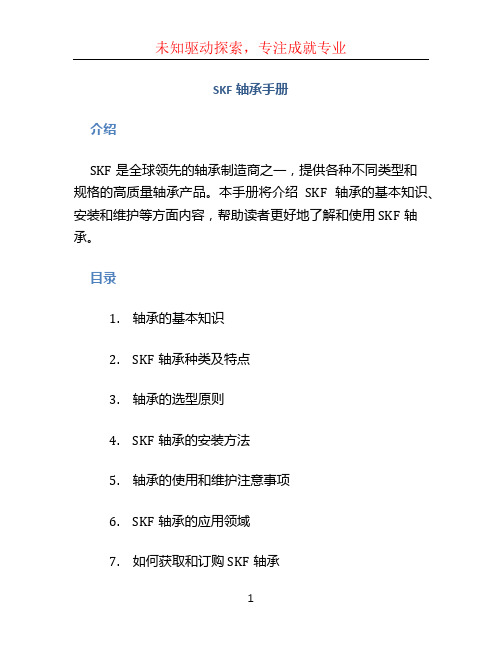
SKF轴承手册介绍SKF是全球领先的轴承制造商之一,提供各种不同类型和规格的高质量轴承产品。
本手册将介绍SKF轴承的基本知识、安装和维护等方面内容,帮助读者更好地了解和使用SKF轴承。
目录1.轴承的基本知识2.SKF轴承种类及特点3.轴承的选型原则4.SKF轴承的安装方法5.轴承的使用和维护注意事项6.SKF轴承的应用领域7.如何获取和订购SKF轴承1. 轴承的基本知识轴承是一种用于减少摩擦和支持机械旋转部件的装置。
它由内圈、外圈、滚动体和保持架组成。
轴承的基本原理是通过滚动体在内圈和外圈之间滚动,从而减少摩擦和支持轴的旋转。
常见的轴承类型包括滚动轴承和滑动轴承。
滚动轴承采用滚动体(如球体或滚子)来减少摩擦,滑动轴承则通过润滑剂减少摩擦。
2. SKF轴承种类及特点SKF生产的轴承种类繁多,包括深沟球轴承、圆锥滚子轴承、圆柱滚子轴承、调心滚子轴承等。
每种轴承都有其特定的应用领域和特点。
•深沟球轴承:适用于高速旋转和较高负载的应用,具有低摩擦和高耐久性的特点。
•圆锥滚子轴承:适用于承受较大径向和轴向负荷的应用,具有高刚度和耐久性。
•圆柱滚子轴承:适用于大型机械设备,具有较高的负载承受能力和良好的耐磨性。
•调心滚子轴承:适用于承受较大偏心或轴向负荷的应用,具有自动调心和高负载承受能力。
3. 轴承的选型原则正确选型轴承对于机械设备的正常运行至关重要。
以下是选型轴承时应考虑的几个因素:•轴承负载:根据机器的负载类型和大小,确定承受能力。
•轴承速度:根据机器的转速要求,选择合适的轴承类型和材料。
•轴承间隙:根据机器的运行条件,选择合适的内圈和外圈间隙。
•环境条件:根据工作环境的温度、湿度等条件,选择合适的轴承材料和润滑方式。
4. SKF轴承的安装方法正确的安装可以确保轴承的使用寿命和性能。
SKF推荐以下安装方法:1.准备工作:清洁轴承座和轴,检查轴承是否有损坏。
2.加热:对于较大尺寸的轴承,可以使用加热器加热轴承或冷却轴座来实现轴承的装配。
《SKF轴承资料》课件
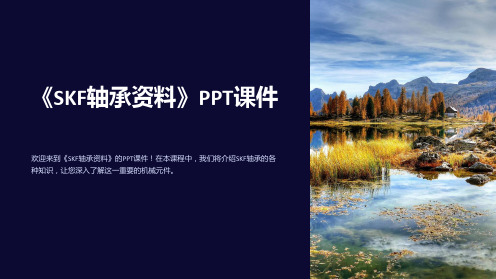
欢迎来到《SKF轴承资料》的PPT课件!在本课程中,我们将介绍SKF轴承的各 种知识,让您深入了解这一重要的机械元件。
一、介绍
SKF轴承的定义
深入解读SKF轴承的定义,了解它在机械设备 中的作用和意义。
SKF轴承的分类
探索SKF轴承的不同分类,了解每种类型的特 点和适用范围。
2 SKF轴承的未来发展趋势
展望SKF轴承的未来发展趋势,包括技术 创新和应用领域的拓展。
机械设备
探索SKF轴承在各种机械设备中的广泛应用,如 工业机械和设备。
汽车工业
介绍SKF轴承在汽车工业中的关键作航空航天领域中的重要性和特殊 要求。
其他应用
展示SKF轴承在其他领域的应用案例,展示其多 样性和适应性。
六、结语
1 SKF轴承的优势
总结SKF轴承的优势,强调其在工业和机 械领域中的重要性。
2 制造工艺
分析制造工艺对SKF轴承质量的影响,如精度、热处理等方面。
3 运行环境
介绍运行环境对SKF轴承的影响,如污染、温度和振动等因素。
四、SKF轴承的检测和维护
1
检测方法
展示用于检测SKF轴承质量和故障的各种方法和工具。
2
维护措施
提供维护SKF轴承的最佳实践,延长其寿命并保持良好运行状态。
五、SKF轴承的应用场景
二、SKF轴承的组成
滚动体
介绍SKF轴承中的滚动体,包括球和滚子,它们 是轴承运转的核心部分。
内外圈
解析SKF轴承的内外圈,探究它们的作用和不同 类型的设计。
保持架
讲述SKF轴承中的保持架,它的作用是保持滚动 体的位置和相互间的距离。
三、SKF轴承的故障原因
skf轴承基础知识资料
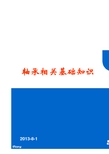
锥形滚子
贝尔令机械
球、滚柱与滚道的接触形式
贝尔令机械
负荷承载能力
贝尔令机械
相对极限速度之比较
贝尔令机械
3、保持架的功能
使滚动体相互之间保持合适的距离,防止相临滚 动体直接接触,以将摩擦和因此而产生的热保持在 最低水平 使滚动体均匀分布在整个轴承内,使负荷能更均 匀的分布和减低噪声 在无载区引导滚动体,以改善轴承中的滚动条件 和防止有损坏性的滑动 对于分离型的轴承,在安装或拆卸其中一个轴承 套圈时,可以把滚动体保持在一体,不至于散落
b:60、62、和 63系列的轴承, 外径大于25mm, 小于或等于52mm 的轴承,带RSL 密封
!!c:其他的轴承带RZ密封圈
flory
带接触式密封圈的轴承
后缀为:RSH、2RSH或RS1、2RS1 根据不同的轴承系列和尺寸,有四种不同的结构设计
a:60、62、
和63系列的轴 承,外径小于 或等于25mm的 轴承,带RSH 密封
Series 63
E2.635-2Z/C3
•
• •
E2深沟球轴 承可以提供 39个型号, 分布于60、 62、63些列 The 外径尺寸从 16-130mm E2深沟子轴 承现在提供 2Z/C3
flory
角接触球轴承
单列角接触球轴承
Single Row ACBB (SRACBB)
双列角接触球轴承
Double Row ACBB (DRACBB)
b.带嵌入铆钉的组合式机削保持架 d.双叉型机削保持架 f.注塑卡型保持架
贝尔令机械
保持架的类型
支柱型保持架
只用于特大型的滚子轴承
特点:以销钉贯通带穿孔的滚子。重量相对较轻,可以容纳更多的滚子。
skf滚动轴承与滑动轴承
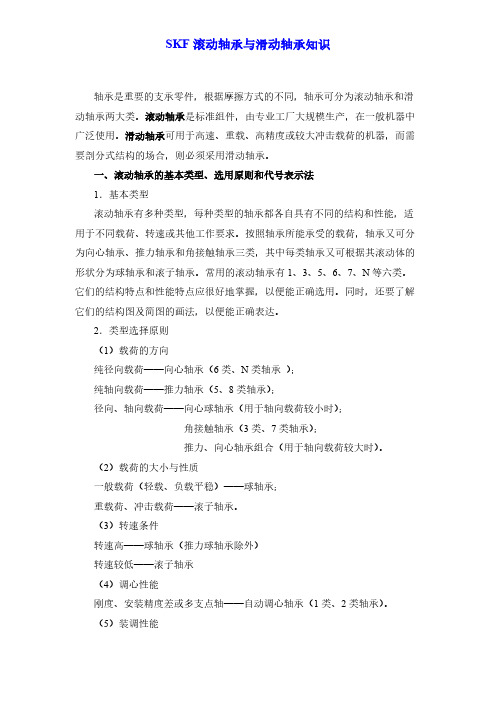
轴承是重要的支承零件,根据摩擦方式的不同,轴承可分为滚动轴承和滑动轴承两大类。
滚动轴承是标准组件,由专业工厂大规模生产,在一般机器中广泛使用。
滑动轴承可用于高速、重载、高精度或较大冲击载荷的机器,而需要剖分式结构的场合,则必须采用滑动轴承。
一、滚动轴承的基本类型、选用原则和代号表示法1.基本类型滚动轴承有多种类型,每种类型的轴承都各自具有不同的结构和性能,适用于不同载荷、转速或其他工作要求。
按照轴承所能承受的载荷,轴承又可分为向心轴承、推力轴承和角接触轴承三类,其中每类轴承又可根据其滚动体的形状分为球轴承和滚子轴承。
常用的滚动轴承有1、3、5、6、7、N等六类。
它们的结构特点和性能特点应很好地掌握,以便能正确选用。
同时,还要了解它们的结构图及简图的画法,以便能正确表达。
2.类型选择原则(1)载荷的方向纯径向载荷——向心轴承(6类、N类轴承);纯轴向载荷——推力轴承(5、8类轴承);径向、轴向载荷——向心球轴承(用于轴向载荷较小时);角接触轴承(3类、7类轴承);推力、向心轴承组合(用于轴向载荷较大时)。
(2)载荷的大小与性质一般载荷(轻载、负载平稳)——球轴承;重载荷、冲击载荷——滚子轴承。
(3)转速条件转速高——球轴承(推力球轴承除外)转速较低——滚子轴承(4)调心性能刚度、安装精度差或多支点轴——自动调心轴承(1类、2类轴承)。
(5)装调性能圆锥滚子轴承内外圈可分离,既便于装拆又利于调整轴承间隙。
3.代号表示法滚动轴承的代号由基本代号、前置代号和后置代号构成。
前置代号表示轴承的分部件代号,基本代号表示其类型和尺寸,后置代号为补充代号,表示轴承在结构、公差和材料等方面的特殊要求。
学习者要以轴承的基本代号为重点,熟悉代号中每个数字的意义。
(1)内径尺寸代号位于右起第一、二位数、要注意掌握表达规律。
(2)尺寸系列代号位于右起第三、四位数、表示轴承的直径系列和宽度系列尺寸。
(2)轴承类型代号位于右起第五位数字,表示轴承的类型,向心球轴承可不标注。
Skf轴承知识

Skf 轴承知识 1.概述滚动轴承滚动轴承由于是滚动摩擦,∴摩擦阻力小,发热量小,效率高,起动灵敏、维护方便,并且已标准化,便于选用与更换,因此使用十分广泛。
一、滚动轴承的构造标准滚动轴承的组成:内圈1、外圈2、滚动体3(基本元件)、保持架4一般内圈随轴一起回转,外圈固定(也有相反)内外圈上均有凹的滚道,滚道一方面限制滚动体的轴向移动,另一方面可降低滚动体与滚道间的接触应力。
球——滚珠轴承—— 滚动体的形状 短圆柱形 柱形 长圆柱形螺旋滚子 滚柱轴承 圆锥滚子 鼓形滚子 滚针保持架能使滚动体均匀分布以避免滚动体相互接触引起磨损与发热 二、滚动轴承的材料内、外圈、滚动体;GCr15、GCr15-SiMn 等轴承钢,热处理后硬度:HRC60~65 保持架:低碳钢、铜合金或塑料、聚四氟乙烯 三、滚动轴承的特点优点:1)f 小起动力矩小,η高;2)运转精度高(可用预紧方法消除游隙);3)轴向尺寸小;4)某些轴能同时承受Fr 和Fa ,使机器结构紧凑;5)润滑方便、简单、易于密封和维护;6)互换性好(标准零件)缺点:1)承受冲击载荷能力差;2)高速时噪音、振动较大;3)高速重载寿命较低;4)径向尺寸较大(相对于滑动轴承)应用:广泛应用于中速、中载和一般工作条件下运转的机械设备。
2 滚动轴承的主要类型、特点和代号一、滚动轴承的主要类型与特点接触角α——外圈与滚动体接触处的法线与垂直于轴线的平面的夹角。
类型——按承载方向:向心轴承——︒=0α,主要承受径向载荷,可受一定Fa ,如深沟球、圆柱滚柱轴承等,1、4、6、N 、NA 、2调心滚子等推力轴承——︒=90α,5(推力球),8(推力圆柱滚子)向心推力轴承——︒<<︒900α:︒<<︒450α—向心角接触轴子(0、3、7) ︒<<︒9045α—推力角接触轴承,2(推力调心滚子轴承) 按滚动体形状:球~——承载能力低,极限转速高 滚子~——承载能力高,极限转速低 常用滚动轴承的类型与特性见表注意代号结构特点:承受载荷的大小,方向,极限转速高低,是否有调心性能等 特别注意最常用几种①深沟球轴承(向心球轴承)——6(0)主要承受径向载,也可受一定双向轴向载荷,f 小精度高,结构简单,价格低,最常用。
SKF轴承术语
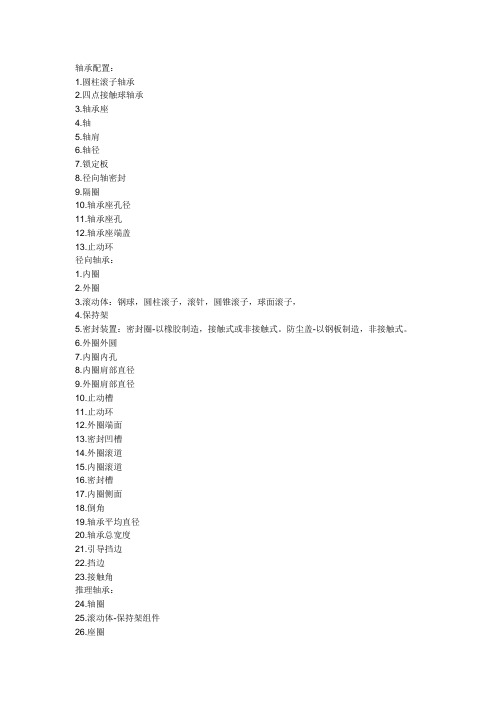
1.圆柱滚子轴承2.四点接触球轴承3.轴承座4.轴5.轴肩6.轴径7.锁定板8.径向轴密封9.隔圈10.轴承座孔径11.轴承座孔12.轴承座端盖13.止动环径向轴承:1.内圈2.外圈3.滚动体:钢球,圆柱滚子,滚针,圆锥滚子,球面滚子,4.保持架5.密封装置:密封圈-以橡胶制造,接触式或非接触式。
防尘盖-以钢板制造,非接触式。
6.外圈外圆7.内圈内孔8.内圈肩部直径9.外圈肩部直径10.止动槽11.止动环12.外圈端面13.密封凹槽14.外圈滚道15.内圈滚道16.密封槽17.内圈侧面18.倒角19.轴承平均直径20.轴承总宽度21.引导挡边22.挡边23.接触角推理轴承:24.轴圈25.滚动体-保持架组件26.座圈28.座垫圈(此术语有图片)英文我现在不会,请请教别人~~~~轴承术语词汇表A |B |C |D |E |F |G |H |I |J |K |L |M |N |O |P |Q |R |S |T |U |V |W |X |Y | Z-----A back to top-----ABEC:Annular Bear ing Engineers Committee. Used as a prefix for tolerance grades of bear ings as set up by this committee.ABEC 1, 3, 5, 7, 9:Annular Bear ing Engineers Committee classes or grades of ball bearing prec ision.ABMA:Amer ican Bear ing Manufacturers Association. This is a non-profit association consisting of American manufacturers of anti-friction bearings, spher ical plain bearings or major components thereof. The pur pose of ABMA is to define national and inter national standards for bear ing products and maintain bearing industry statistics.ABRASION:The wear ing away of a surface by mechanical action such as rubbing, scraping or erosion.ABRASIVE BLASTING:Process for removing scale from product after heat treatme nt and prior to grinding; product pieces are placed in a tumbler that bombards the surface with high-velocity metal shot particles. This process also acts as a tempering or stabilizing process. (Also called Shotblasting)ABRASION RESISTANCE:The ability of a rubber compound to resist mechanical wear.ABS (ANTILOCK BRAKE SYSTEM):Ability to brake and steer at the same time. A braking system, usually electronically controlled, that prevents wheel lock during heavy brake application.ACCELERATED LIFE TEST:Any set of test conditions designed to reproduce in a short time the deteriorating effect created under nor mal service condition.ACID ETCH:The process of checking surface of ground product for cracks or burns by using a ser ies of acids or neutr alizers. Also called Nital Etch.ALL PURPOSE BEARING:The Timk en Company "AP" Bearing; a self-contained pre-assembled, pre-adjusted, pre-lubricated, completely sealed unit. Applied to and removed from an axle without exposing the bearing elements, seal or lubricant to contamination or damage.AMBIENT TEMPERATURE:The surrounding temperature. Note that ambient temperature is not necessarily the same as atmospheric temperature.AMERICAN NATIONAL STANDARDS INSTITUTE - ANSI:An agency that develops standards and requirements regarding all things which affect the health and safety of associates.ANGULAR CONTACT BEARING:A type of ball bearing whose internal clearances and ball race locations result in a definite contact angle between the races and the balls when the bear ing is in use.ANSI:The American National Standar ds Institute is a pr ivate or ganization that identifies industr ial standards and coordinates their development. Many ANSI standards relate to safe design, perfor mance and practices for equipment.ANTI-FRICTION BEARING:These bearing types use rolling contact to cut power loss resulting from friction.ANTI-OXIDANT:An additive that is usually incorpor ated in a r elatively small proportion to retard oxidation of lubricants, including greases and gear lubricants. It is an oxidation inhibitor.ANTI-RUST OR ANTI-CORROSION ADDITIVES:These additives help pr event ox idat ion of metal by displacing water from metal surfaces. They plate to metal with a polar ized effect to give the metal an internal “umbrella,”helping to deter ir on-oxide for mation.APEX:The common point on the axis of a bearing where angular lines of each of the var ious tapered roller surfaces meet.AXIAL CLEARANCE:The gap between the toe face of the head section and the inside surface of the inner case.AXIAL INTERNAL CLEARANCE:In a ball bearing assembly, the axial internal clearance is the total maximum possible movement parallel to the bearing axis or the inner ring, in relation to the outer ring.AXIAL LOAD:A type of load on a bearing that is parallel to the axis of rotation.AXIAL RUNOUT:Also called lateral runout, is the measurable irregularity or wobble parallel to the axis of rotation.AXIS:A straight line about which an object rotates; a straight line about which the parts of a bearing are regular ly arranged. The center line of a shaft serves as an ax is for a bearing; the cup and housing remain stationary while the shaft and cone rotate OR the cone and shaft remain stationary and the cup and housing rotate around it. The relative motion of the cup and cone is accommodated by the rolling motion of the r ollers.AXLE:Rod or spindle on or with which a wheel revolves; the bar connecting two opposite wheels. The shaft (axle) of an automobile fits thr ough the bore of a cone of the tapered roller bearing.-----B back to top-----BALL:A spher ical rolling element.BALL BEARING:An anti-fr iction bearing that uses a series of steel balls held between inner and outer bearing races.BALL DETENT:A spring-loaded ball mechanis m that aligns the needle r ollers of a full complement drawn cup bear ing before it is pressed into a housing. The r ollers are aligned when the ball detent forces the rollers apart, gathering circumferential clearance in one location.BENCH TEST:A modified service test in which service conditions are approximated using conventional laboratory equipment, not necessarily application-identical equipment.BO RE:The inside diameter of the inner ring or cone.BO RE CORNER:The max imum shaft fillet radius that will prov ide for proper bearing fit.BO RE SIZE:The inner diameter of a cone, which accommodates a shaft.BO UNDARY LUBRICATION:A state of lubrication that occurs when, due to speed, load or lubricant combination, the “thick film”or hydrodynamic conditions do not completely separate the rubbing surfaces. Spec ial additives sometimes are used for bearing protection under these conditions.BRUISING:A for m of bearing surface damage from other fatigued parts.-----C back to top-----CAGE:The separator that spaces and holds rolling elements in their proper pos itions along the races.CAGE DEFORMATION:Improperly installed or dropped bear ing.CAGE POCKET WEAR:Heavy contact between the rollers and cage pocket surfaces caused by a bearing's operating too loosely.CAGED BEARING:Similar to a full complement bear ing, except that there ar e fewer rollers, allowing room for the cage.CLOSED-END BEARING:A drawn cup bearing where one end of the cup has a solid face, which fully enc loses that end of the bear ing. This allows the housing to be through bored (straight housing). The closed end of the installed bearing seals the housing.CO EFFICIENT OF FRICTION:The ratio of the friction between two surfaces to the pressure between them. A low coefficient of friction means low fr iction losses that are influenced by the v iscosity and character of the lubricant and by materials, surface conditions and other factors.COHESION:The molecular attraction between grease particles that causes them to stick together. This attraction contributes to its resistance to flow.COMBINED LOAD:Both r adial and thrust loads applied to the same bear ing at one time.CONE:The bearing's inner ring that is fixed to and/or pressed onto a r otating shaft.CONE BORE DAMAGE:Fractured cone due to out-of-round or over-sized shaft.CONE LARGE RIB FACE DEFORMATION:Metal flow from excessive heat generation.CONE LARGE RIB FACE SCORING:Welding and heat damage from metal-to-metal contact.CONRAD DEEP-GROOVE BALL BEARING:Standard single-row deep-groove bearing. Also referred to as a radial ball bearing.CONTACT LINE HEIGHT:The axial distance from the outside seal face to the lip contact line.CONTACT POINT:The line of intersection between the outside and inside lip surfaces of a radial lip seal. In a cross-sectional view, this intersection is illustrated as a point.CONTAMINATION:The pollution of a lubr icant by an exter nal agent.CORRO SION:A chemical attack on metals by acids, alkalies, oxygen, chlorine, sulfur or other chemicals. This is distinct from metal destruction by wear and may be evident by either discoloration or pitting.CORRO SION INHIBITOR:An additive that protects lubricated metal surfaces from chemical attack by water or other contaminants.CUP:The bearing's outer ring that sits on the hous ing and remains stationary during rotation.CUP-FACE DENTING:Indentations from hardened driver.CUP SPINNING:A loose cup fit in a rotating wheel hub.-----D back to topDEAD-END HOUSING:A housing that is not through bored. The machining stops part way through the housing for ming a blind hole.DIAL INDICATOR:A measuring dev ice, equipped with a r eadout dial, used most often to deter mine end motion orirregularities/runout.DRAWN CUP NEEDLE ROLLER BEARING:A needle roller radial bearing with a thin, pressed steel outer ring (drawn cup). It is usually employed without an inner r ing. Available in caged and full complement designs. Drawn cup bearings are nor mally supplied with both ends open, but most sizes are also available with one end closed. A drawn cup bearing can only carry a radial load.DYNAMIC SEAL:A seal required to prevent leakage past parts that are in relative motion.-----E back to top-----ECCENTRIC:Circles or diameters not hav ing the same exact centers.ECCENTRICITY:This is deter mined by measuring the shaft runout, TIR and the shaft-to-bore misalignment.ELASTOHYDRODYNAMIC LUBRICATION (EHD):A lubricant regime characterized by high-unit loads and high speeds where the mating parts, usually in roller bearings, defor m elastically, causing an increase in lubricant viscosity and load-carrying capacity.END PLAY:The amount of axial or end-to-end movement in a shaft due to clearance in the bearings.ETCHING:Rusting with pitting and corrosion from moisture and water exposure.EVAPORATION LO SS:The portion of a lubricant that evaporates under the effects of temperature, pressure and time. The test methods inc lude ASTM D 972 and ASTM D 2595.-----F back to topFACE:The side surface of a bearing.FALSE BRINELLING:Wear caused by vibration or relative ax ial movement between the rollers and races. (See Fretting.)FATIGUE:The fracture and breaking away of metal in the for m of a spall. G enerally, three modes of contact fatigue are recognized:Inclusion or iginGeometr ic stress concentrationPoint surface originFILLET RADIUS:Shaft or housing corner dimension that bearing corner must clear.FIXED BEARING:Bearing which positions shaft against axial movement in both directions.FLO ATING BEARING:Bearing so designed or mounted as to per mit axial displacement between shaft and housing.FLUTING:A series of s mall axial burns caused by an electric current passing through the bearing while it is rotating.FPM:Feet per minute.FRETTING:Wear characterized by the r emoval of fine particles from mating surfaces. Fretting is caused by v ibratory or oscillatory motion of limited amplitude between contacting surfaces. (See False Brinelling.)FRICTION:Resistance to motion due to the contact of surfaces.FRICTION BREAK-OUT:Friction developed dur ing initial or starting motion.FRICTION RUNNING:Constant friction created during the operation of a dynamic seal.FULL COMPLEMENT BEARING:A bearing without a cage that contains the maximum number of rollers and has maximum load carrying ability. The rollers are mechanically retained by the cup in most full complement drawn cup bearings.-----G back to top-----GALLING:A for m of wear in which seiz ing or tear ing of the gear or b earing surface occurs.GEO METRIC STRESS CONCENTRATION:Spalling from misalignment, deflections or heavy loading.GROOVING:Large particle contamination imbedding into the soft cage material.GROSS MARGIN:The difference between the cost of merchandise and its selling pr ice.-----H back to top-----HARDNESS:The resistance to indentation. This is measured by the relative resistance of the mater ial to an indentor point of any one of a number of standard hardness testing instruments.HDLTM:Timken Hydrodynamic Labyrinth (HDLTM) Seal.HEAD SECTION:The portion of a lip seal that is generally defined by the inside and outside lip surfaces and the spring groove.HEAVY-DUTY NEEDLE ROLLER BEARINGS:A needle roller radial bearing with a machined and ground channel-shaped outer ring with a complement of needle rollers, retained and guided by a cage. A heavy-duty needle roller bearing can only carry a radial load.HEAVY PARTS:Examples of heavy parts are chassis (shock absorbers, mufflers and exhaust system products, struts), drivetrain (U-joints, tr ans mission parts, clutches), brake parts (rotors, discs) and crash parts (body repair kits, fenders and bumpers, fiberglass panels, glass).HIGH SPOTS IN CUP SEATS:Localized spalling on the cup race from stress riser created by a split housing pinch point.HOUSING:A rigid structure that supports and locates the seal assembly with respect to the shaft.HOUSING FITAmount of interference or clearance between bear ing outside surface and hous ing bear ing seat.HUB BEARING ASSEMBLY:A packaged wheel-end unit that contains bear ings, seals and all components necessary for easy installation. It is pre-sealed, pre-lubricated and pre-set for precise perfor mance.HUB GREASE CAP/DUST CO VER:A metal cap that fits over the outer end of the hub to keep grease in and dirt out of the bearing assembly.HYDRODYNAMIC (FLUID-FILM) LUBRICATION:That state of lubr ication in which the shape and relative motion of the sliding surfaces cause the for mation of a continuous fluid film under sufficient pressure to prevent any contact between the surfaces. It is commonly called fluid-film lubr ication.-----I back to top-----INCLUSION ORIGIN:Spalling from oxides or other hard inclusions in the bearing steel.INNER CASE:A rigid, cup-shaped component of a seal assembly that is placed inside the outer seal case. It has one or more of the following dev ices: reinforcing member, shield, spr ing r etainer or a lip-clamping component.INNER RING:Bearing component with the inner raceway on its OD surface.INNER RING RACE:The surfaces on the cup and cone where the rolling elements make contact.INSIDE CASE INNER DIAMETER:The inner diameter of the inner case of a radial-lip seal.INSIDE FACE:The surface of the inner case that faces and is usually in contact with the sealed fluid.INSIDE LIP ANGLE:The angle between the ins ide lip surface and the ax is of the seal case.INSIDE LIP SURFACE:The inside truncated conical surface of the lip.INTERNAL CLEARANCE:The internal clearance of a single-row radial contact ball bearing is the average outer ring race diameter, minus the average inner r ing r ace diameter, minus twice the ball diameter. It also is known as the radial inter nal clearance or end play.INTERNATIONAL ORGANIZATION FOR STANDARDIZATION:Most commonly referred to as the ISO STANDARD. An international standard setting body that is composed of representatives fr om various national standards organizations.-----L back to top-----LIFE TEST:A laboratory procedure that is used to deter mine the amount and duration of r esistance of an artic le to a specific set of destructive forces or conditions.LINE SPALLING:Roller spaced spalling from bearings oper ating after etching damage.LIP HEIGHT:The axial distance from the outside seal face to the toe face.LIP LENGTH:The axial distance between the thinnest part of the flex section and the contact line.LO AD-CARRYING CAPACITY:The property of a lubricant that for ms a film on the lubricated surface, which resists rupture under given load conditions. It is expr essed as the max imum load the lubricated system can support without failure or excessive wear.LUBRICANT:Any substance used to separ ate two surfaces in motion and reduce the friction or wear of the surfaces.LUBRICATION:The control of friction and wear by introducing a friction-reducing film between mov ing surfaces that make contact. It may be a fluid, solid or plastic substance.LUBRICITY:A ter m used to describe the ability of a lubricant to reduce friction between rubbing surfaces. There are no generally accepted test methods available to evaluate this property. Lubricity is important mostly in conditions of boundary lubrication and probably represents some relationship to the ability of the oil to wet the bear ing surfaces and to resist being rubbed off. Lubric ity has no known dir ect relationship to oil viscosity. It is also referred to as oiliness.-----M back to top-----MAXIMUM CAPACITY BEARING:A bearing with filling notches to allow the loading of the max imum number of balls.METAL (OUTER) CASE:The outer, thin-wall, r igid structure of the lip-seal assembly that contains the primary sealing ring and, if pr esent, the inner case, spring and secondary seal.MISALIGNMENT:An irregular roller path fr om deflection, inaccurate machining or wear of bearing seats.-----N back to top-----NEEDLE ROLLER:Cylindrical r oller with large length to diameter ratio. The length is between three and ten times the diameter, which does not usually exceed 5 mm. The ends of the needle roller may be one of several shapes.-----O back to top-----OPEN-END BEARING:A drawn cup bearing that does not have a closed end. This allows a shaft to extend through the bearing.OUTER RING:A bearing component with the outer raceway on its bore surface.OUTER RING RACE:The ball or roller path on the bore of the outer r ing.OUTSIDE CASE INNER DIAMETER:The inside or s mallest diameter of the outer case of a lip-seal assembly.OUTSIDE DIAMETER:The diameter of the outer ring or cup. It also is known as O.D.OUTSIDE FACE:The surface of the seal case perpendicular to the shaft axis that is not in contact with the fluid being sealed.OUTSIDE LIP ANGLE:The angle between the outside lip surface and the ax is of the seal case.OUTSIDE LIP SURFACE:The outs ide truncated conical surface of the lip.OVERALL BEARING WIDTH:The overall dimension when the cup and cone are mated, including rollers and cage.OXIDATION:This occurs when oxygen attacks petro leum fluids. The pr ocess is accelerated by heat, light, metal catalysts and the presence of water, acids, or solid contaminants. It leads to increased viscosity and deposit for mation.OXIDATION INHIBITOR:A substance (chemical additive) added in s mall quantities to a petroleum product to increase its oxidation resistance, thereby lengthening its service or storage life.OXIDATION STABILITY:The resistance of a petroleum pr oduct to oxidation and, therefore, a measure of its potential service or stor age life.-----P back to top-----PEELING:Micro-spalling due to a thin lubricant film from high loads/low RPM or elevated temperatures.PITTED:Small indentations appear ing as black dots on finished surfaces of any piece of product; undesirable surface defects.PO INT SURFACE ORIGIN:Spalling from debr is or raised metal exceeding the lubr icant film thickness.PRELOAD:Thrust load applied to bearings that support a rotating part; eliminates axial endplay or movement.-----R back to top-----RACES:The surfaces on the cup and cone where the rolling elements make contact.RACEWAY:The functional surfaces in an anti-fr iction bearing that contact the rolling elements.RADIAL DEVIATION:The amount of deviation from the true circular for m.RADIAL INTERNAL CLEARANCE:Also called radial clearance. It is the total distance the inner ring (or shaft) may be displaced relative to the outer ring of an assembled, installed bear ing.RADIAL LO AD:A load applied perpendicular to the axis of the shaft.RADIAL RUNOUT:Measurable irregular ity or out-of-roundness in a rotating assembly, at a r ight angle to an axis.RIB (HELIX):In seals, a long, narrow projection that is nor mally triangular in the cross section. It is molded into the outside lip surface of a helix seal. The rib is oriented at an angle to the shaft axis. One end of the rib for ms part of the seal-lip contact surface. In tapered r oller bearings, it is a raised structure at the end of the raceway that guides or supports the rollers.RMS:Root mean square.ROLLER BINDING SKEWING:Cage r ing compressed during installation or interference dur ing service.ROLLER END SCORING:Metal-to-metal contact resulting fr om the breakdown of lubr icant film.ROLLER NICKING/DENTING:Damage from rough handling or installation damage.ROLLER SPACE NICKING:Raised metal on races from contact with roller edges.ROLLERS:Rolling elements that are located between the cone and cup.RUNOUT:Measurable irregular ity across a plane surface, such as a disc brake rotor, hub or wheel assembly.RUNOUT (SHAFT):This is the same as gyration. When it is expressed in inches alone or accompanied by the abbr eviation TIR (total indicator reading), it refers to twice the radial distance between the shaft axis and ax is of rotation.-----S back to top-----SCALLOPING:Uneven localized wear resulting from excessive endplay.SCUFFING:Abnor mal wear due to localized welding and fracture. It can be prevented thr ough the use of anti-wear, extreme-pressure and fr iction-modifier additives.SENSOR-PAC™BEARING:A light-duty packaged bearing that includes a sensing system for antilock brak e and tr action control systems.SHAFT FIT:Amount of interference or clearance between bear ing inside diameter and shaft bearing seat outside diameter.SHAFT HARDNESS:The resistance to indentation. At minimum, it should be Rockwell C45.SHAFT LOBING:Unifor m radial dev iation of the shaft surface. An oval shaft is said to have two lobes. Faulty center less grinding usually causes an odd number of lobes to occur. Higher order lobing is also referred to as chatter.SHAFT OUT-OF-ROUND:The deviation of the shaft cross section from a true click. Out-of-round is measured as the radial distance, on a polar chart recording, between concentric, circumscribed and inscribed circles that contain the trace and are centered to minimize the radial distance.SHAFT TOLERANCE:This is the allowable var iation in the shaft diameter.SPALLING:Metal flaking (off) of the race or roller caused by inclusions in bearing steel, misalignment, deflection or heavy loading.SPINDLE:A short tapered axle that supports a free r olling wheel. Also referred to as a stub axle.SPINDLE NUT:A nut threaded on the end of the spindle for adjusting the wheel bear ing endplay or preload.SPLINES:External or internal slots or grooves cut in a shaft/gear/hub or yoke used so that two different components must rotate together.STAINING:Surface stain with no s ignificant corrosion from moisture exposure.STATIC POINT:The section of the helix seal lip incorporating the contact line.STRAIGHT HOUSING:A hous ing that is through bored. The machining passes all the way through the housing for ming a thr ough hole.STRAIGHT MINERAL OIL:A petr oleum oil not containing compounds, animal or vegetable oils or chemical additives.-----T back to top-----TAPERED ROLLER BEARING:A friction reducing bearing that is made up of a cup, cone and tapered rollers, which rotate around the raceway of the bear ing.THERMAL EXPANSION:The expansion caused by the increase in temperature. This may be linear or volumetr ic.THRUST:The continuous pressure of one object against another, parallel to the center of the axis.THRUST LO AD:A load applied parallel to the center line of rotation.THRUST NEEDLE BEARINGS:A needle roller thrust bearing contains a cage that holds needle rollers in a spoke-like configuration. A thrust needle roller bear ing can only carry a thrust load.TIER ONE SUPPLIERS:Automotive parts manufacturers that supply final equipment directly to automakers (OEMs or original equipment manufacturers). Increasingly, tier one suppliers are becoming "systems integrators" or producers of major subassemblies and modular components that can be installed into a vehic le as a unit, such as a complete chassis.TORQUE:The turning force of a shaft.TORQUE WRENCH:A torque wrench measures the amount of turning force being applied to a fastener (nut or bolt). Scales usually read in foot-pounds or Newton-meters.TRUE BRINELLING:Damage from shock or impact.TRUE ROLLING MOTION:Tapered roller bearings natur ally align thems elves as a result of the balance of forces on the bearing, keeping rolling elements mov ing s moothly in wheels and other automotive applications.-----U back to top-----UNIPAC-PLUS™BEARING:An enhanced UNIPAC design that incorporates a flange to ease mounting of the bear ing assembly.UNIPAC™BEARING:A double-row tapered bear ing configuration originally designed for light- and heavy-duty automotive applications.UNIT BEARING:An automotive bear ing that is sold as an assembled set and is non-adjustable; character ized by a cone with no large r ib.-----W back to top-----WEAR:Damage resulting from the removal of materials from surfaces in relative motion. Wear is generally described as:Abrasive: Removal of materials from surfaces in relative motion by a cutting or abrasive action of a hard particle, which is usually a contaminant.Adhes ive: Removal of materials from surfaces in relative motion as a result of surface contact. Galling and scuffing are the extreme cases.Corrosive: Removal of materials by chemical action.-----Z back to top-----ZERO CLEARANCE:No clear ance between the roller and races.。
skf轴承手册
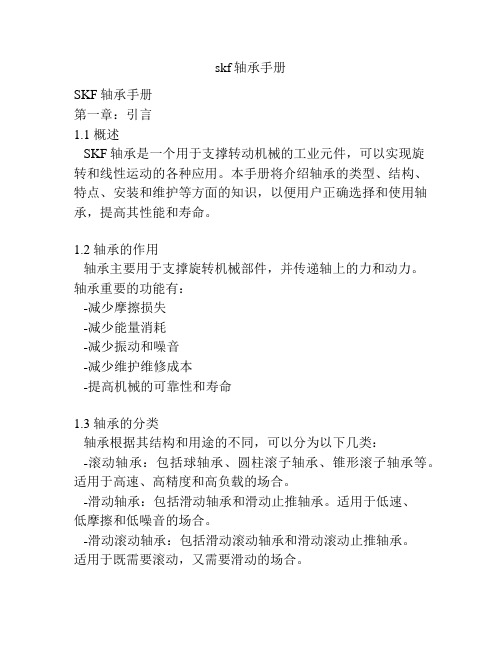
skf轴承手册SKF轴承手册第一章:引言1.1 概述SKF轴承是一个用于支撑转动机械的工业元件,可以实现旋转和线性运动的各种应用。
本手册将介绍轴承的类型、结构、特点、安装和维护等方面的知识,以便用户正确选择和使用轴承,提高其性能和寿命。
1.2 轴承的作用轴承主要用于支撑旋转机械部件,并传递轴上的力和动力。
轴承重要的功能有:-减少摩擦损失-减少能量消耗-减少振动和噪音-减少维护维修成本-提高机械的可靠性和寿命1.3 轴承的分类轴承根据其结构和用途的不同,可以分为以下几类:-滚动轴承:包括球轴承、圆柱滚子轴承、锥形滚子轴承等。
适用于高速、高精度和高负载的场合。
-滑动轴承:包括滑动轴承和滑动止推轴承。
适用于低速、低摩擦和低噪音的场合。
-滑动滚动轴承:包括滑动滚动轴承和滑动滚动止推轴承。
适用于既需要滚动,又需要滑动的场合。
第二章:滚动轴承2.1 球轴承球轴承是最常见的滚动轴承类型,由内外圈、钢球、保持架和密封圈组成。
它们可以承受来自各个方向的轴向和径向载荷,并适用于中小型机械设备的转动部件。
2.2 圆柱滚子轴承圆柱滚子轴承具有较大的径向载荷能力和较高的刚度,适用于高速和高负载的场合。
它们由内外圈、滚子、保持架和密封圈组成。
2.3 锥形滚子轴承锥形滚子轴承具有较大的径向载荷能力和较高的刚度,适用于受到轴向载荷和径向载荷的同时作用的场合。
它们由内外圈、滚子、保持架和密封圈组成。
2.4 轴承的安装和拆卸在安装轴承之前,必须仔细清洁轴承和轴承座,并涂抹适当的润滑脂。
安装时要遵循正确的方法和使用适当的工具。
拆卸时要注意轴承的位置并使用适当的拆卸工具。
第三章:滑动轴承3.1 滑动轴承的分类滑动轴承按照其用途和工作原理的不同,可以分为滑动轴承和滑动止推轴承。
3.2 滑动轴承滑动轴承是由两个金属表面之间的润滑剂膜支撑着工作的。
它们适用于低速和低摩擦的场合,常见的类型有杂化滑动轴承和复合材料滑动轴承。
3.3 滑动止推轴承滑动止推轴承是在滑动轴承的基础上增加起推力的功能。
- 1、下载文档前请自行甄别文档内容的完整性,平台不提供额外的编辑、内容补充、找答案等附加服务。
- 2、"仅部分预览"的文档,不可在线预览部分如存在完整性等问题,可反馈申请退款(可完整预览的文档不适用该条件!)。
- 3、如文档侵犯您的权益,请联系客服反馈,我们会尽快为您处理(人工客服工作时间:9:00-18:30)。
SKF 轴承知识大全SKF 轴承简介,SKF 轴承型号的含义,NSK 公司概述,SKF 轴承故障排除 and so on.1:SKF 轴承简介:SKF 的全称是“Svenska Kullager-Fabriken”中文音译名称为“斯凯孚”;2:SKF 轴承型号的含义SKF 公司的滚动轴承,滚动轴承部件及附件的完整代号由基本代号和补充代号组成。
基本代号由轴承类型代号,尺寸系列代号和内径代号构成。
表示轴承的基本类型,结构和尺寸,是轴承代号的基础。
补充代号是轴承结构形状,尺寸,公差,技术要求有改变时在基本代号左右添加的代号。
在基本代号左边添加的代号为前置代号,用以识别轴承部件,在基本代号右边添加的代号为后置代号,用以表示与原设计有区别或与现行生产的标准有差异的设计问题。
1)前置代号GS——推力圆柱滚子,推力滚针轴承座圈。
例:GS81107-推力圆柱滚子轴承 81107 的座圈。
K——推力滚子和保持架的组合件里。
例:K81170。
K-——符合 AFBMA 标准系列英制圆锥滚子轴承带滚子和保持架组件的内圈(内锥体)或外圈(锥环)。
例:K-09067——系列为 09000 的圆锥滚子轴承的内锥体。
L——分离型轴承的单一内圈或外圈。
例:LNU207——圆柱滚子轴承 NU207 的内圈。
L30207——圆锥滚子轴承 30207 的外圈。
R——除去单一内圈或外圈的分离型轴承。
例:RNU207——圆柱滚子轴承 NU207 带滚子和保持架组合件的外圈。
R30207——圆锥滚子轴承和保持架组件的内圈。
WS——推力圆柱滚子,推力滚针轴圈。
例:WS81107——推力圆柱滚子轴承 81107 的轴圈。
2.后置代号如果轴承代号中有数个后置代号,则这些后置代号按以下顺序分组排列:(1)内部设计,(2)外部设计,(3)保持架,(4)其他特点。
(1)(2)(3)组中的后置代号与基本代号之间留出半个汉字距;(2)组中的防尘盖和密封圈的后置代号则是例外,在后置代号前面置一个连字符“-”;(4)组中的后置代号前面置一斜线。
斜线也用来隔离下列两种情况下的两个(4)组后置代号:a. 第一个后置代号以数字结尾和第二个后置代号以数字开头时。
例:6205/P53/223316。
B. 表示压缩和(/或)移动游隙范围的后置代号后再跟一表示润滑脂类型的后置代号,若省略斜线会引起混淆时。
例;6205-2Z/C2L/HT42(=C2L+HT42)。
(1)内部设计A, B, C, D, E——当正常的内部结构有变动时,这些后置代号及其组合一般构成轴承系列代号的一部分,他们通常只在过渡期使用,过渡期之后即略去不用。
然而,当它们表示某种替代结构时,这些后置代号就会变成永久性的了。
通常它们的含义是某一轴承类型或轴承系列所特有的。
例如:单列角接触球轴承ACD——接触角为 25 度。
B——接触角为 40 度。
CC——接触角为 12 度。
CD——接触角为 15 度。
BE——接触角为 40 度的 BE 型轴承,钢球加大,以玻璃纤维增强尼龙保持架。
双列角接触球轴承A——外径小于等于 90 毫米轴承的标准设计,没有装球缺口,采用玻璃纤维增强尼龙保持架。
E——轴承一侧有装球口,可装较多钢球,因此具有较高的径向及轴向承载能力。
调心滚子轴承CAC,ECAC,CA,ECA——这些设计用于大尺寸的轴承,滚子呈对称型。
内圈两侧具有固定挡边,活动中挡圈以内圈引导。
保持架为整体黄铜或钢制实体架。
CAC 及 ECAC 型轴承滚子和滚道表面经优化加工,有助于滚子引导,并可减少摩擦。
ECAC 型带有加强滚子,以提高负载能力。
CC,C,EC——这类轴承滚子呈对称型,内圈无挡边。
每列滚子带有冲压钢板保持架。
活动中的挡圈由内圈引导。
EC 型轴承采用加强滚子,以提高负载能力。
CC 型轴承滚子和滚道表面经优化加工,有助于滚子引导,并可减少摩擦。
E——是 SKF 公司采用最新标准设计,轴承滚子对称,内圈无挡边,铁青铜制造的活动中挡圈靠近外圈,由保持架引导,每列滚子有一冲压钢板保持架。
E 型轴承具有 CC 型轴承的全部优点,最新发展的保持架可放入更多更大直径的加长滚子,使轴承负载能力更高。
E 型轴承外圈带有油槽及三个油孔,则后置代号中须加 W,以示区别。
圆柱滚子轴承B——轴承采用表面经处理的滚子(满装滚子轴承)。
2 SKF 轴承型号的含义B4——轴承套圈表面及滚子表面均经处理(满装滚子轴承)。
EC——轴承内部几何形状经改进,有较高的承载能力,挡边和滚子端面具有良好的接触和润滑条件,能承受较高的轴向载荷。
(2)外部设计CA,CB,CC——通用配对型单列角接触球轴承,可任意(串联,面对面或背靠背)配对安装。
背靠背或面对面排列时,轴向安装前内部间隙与正常值比:小(CA),正常(CB),较大(CC)。
-2F——外球面球轴承两侧带甩尘挡圈。
-2FF——外球面球轴承两侧带组合甩尘挡圈。
G——通用配对单列角接触球轴承。
面对面或背靠背排列时,轴承内有一定的安装前预载荷。
GA——面对面,背靠背排列时,轴承内有较轻的预载荷。
GB——面对面,背靠背排列时,轴承内有中等预载荷。
GC——面对面,背靠背排列时,轴承内有较重的预载荷。
K——圆锥孔,锥度 1:12。
K30——圆锥孔,锥度 1:30。
-LS——轴承一面具有接触式密封,内圈无密封凹槽。
-2LS——轴承两面具有 LS 密封。
N——轴承外圈上有止动槽。
NR——轴承外圈上有止动槽并有止动环。
N2——外圈倒角上有两个直径方向上相对的槽口。
PP——轴承(支承滚轮轴承,凸轮随动轴承)两面具有接触式密封。
RS——轴承(滚针轴承)一面具有合成橡胶或聚氨基甲酸酯接触式密封。
-RS1——轴承一面具有衬钢板合成橡胶接触式密封。
-2RS1——轴承两面具有 RS1 密封。
-2RS——轴承(滚针轴承)两面具有 RS 密封。
-RZ——轴承一面具有衬钢板合成橡胶的低摩擦密封。
-2RZ——轴承两面具有 RZ 密封。
X——1.基本尺寸经修正以符合 ISO 标准;2.柱形滚动面(支承滚轮轴承,凸轮随动轴承)。
Z——轴承一面具有防尘盖(非摩擦密封)。
-2Z——轴承两面具有防尘盖。
-ZN——轴承一面具有防尘盖,另一面外圈上有止动槽。
-2ZN——轴承两面具有防尘盖,外圈有止动槽。
-2NR——同-ZN,且带有止动环。
-2ZNR——同-2ZN,且带有止动环。
(3)保持架为了表明轴承中保持架的引导方式,保持架的后置代号之后可加字母 A 或 B。
A 表示保持架由外圈引导;B 表示保持架由内圈引导。
无表示的保持架由滚动体引导。
例:MA——黄铜机制保持架,外圈引导。
保持架后置代号之后也可加数字,表示不同的设计或材料。
例;TN9——玻璃纤维增强尼龙模注保持架。
F——钢或特殊铸铁制实体保持架。
J——钢板冲压成形保持架。
M——轻合金实体保持架。
MP——黄铜实体保持架。
P——玻璃纤维尼龙模注保持架。
TN——工程塑料模注保持架。
Y——铜板冲压成形保持架。
V——满滚子轴承(无保持架)。
VH——由非分离型滚子组合件构成的满滚子轴承(圆柱滚子轴承)。
(3)其他特性1)公差等级/CLN——相当于 ISO 公差等级 6X,用于公制圆锥滚子轴承(宽度公差有降低)。
/CL0——相当于 ISO0 级公差,用于英制圆锥滚子轴承。
/CL3——相当于 ISO3 级公差,用于英制圆锥滚子轴承。
/CL7A——符合差速器轴承配置标准的圆锥滚子轴承。
/CL7C——符合差速器轴承配置特殊标准的圆锥滚子轴承。
/P4——尺寸及旋转精度符合 ISO4 级公差(比 P5 精度)。
/P4A——尺寸精度符合 ISO4 级公差,旋转精度相当于 AFBMA 标准 ABEC9 级。
/P5——尺寸旋转精度符合 ISO5 级公差(精度高于 P6)。
/PA9A——尺寸及旋转精度相当于 AFBMA 标准 ABEC9 级。
/PA9B——尺寸精度相当于 AFBMA 标准 ABEC9 级,旋转精度比 PA9A 高。
/SP——尺寸精度约为 P5,旋转精度约为 P4。
/UP——尺寸精度约为 P4,旋转精度高于 P4。
2)轴承游隙/C1——游隙符合标准规定的 1 组,游隙小于 2 组。
/C2——游隙符合标准规定的 2 组,游隙小于 0 组。
/C0——游隙符合标准规定的 0 组,代号中省略,不表示。
3 SKF 轴承型号的含义/C3——游隙符合标准规定的 3 组,游隙大于 0 组。
/C4——游隙符合标准规定的 4 组,游隙大于 3 组。
/C5——游隙符合标准规定的 5 组,游隙大于 4 组。
当游隙代号与轴承公差级代号 P4,P5 或 P6 结合时,游隙代号 C 可省去。
例:P6+C2=P623)特殊技术要求。
/Q——最佳内部几何结构和表面粗糙度(用于圆锥滚子轴承)。
/Q66——振动水准小于普通级标准,振动峰值小于普通级标准。
/QE5——符合电机用特别标准,尺寸及旋转精度达 P6.极低噪音。
/QE6——符合电机用标准,低噪音。
4)轴承配置。
/DB——两个可配对单列深沟球轴承,单列角接触球轴承或单列圆锥滚子轴承以背靠背方式成对安装。
DB之后的数字表示轴向游隙大小或安装时的预载荷大小。
A——轻预载荷(角接触球轴承)。
B——预载荷比 A 大(角接触球轴承)。
C——预载荷比 B 大(角接触球轴承)。
CA——内部游隙较小(深沟或角接触球轴承)。
CB——内部游隙较 CA 大(深沟或角接触球轴承)。
CC——内部游隙较 CB 大(深沟球轴承)。
CG——“零”游隙(圆锥滚子轴承)。
C…——特殊轴向内部游隙 CC 后面的数字表示轴向游隙大小。
GA——较轻预载荷(深沟球轴承)。
GB——预载荷大于 CA(深沟球轴承)。
G…——特殊预载荷(G 后面的数字表示预载荷的大小)。
例:6208/DBGA——表示两个背靠背安装的具有轻度载荷 6208 型深沟球轴承。
/DF——两个面对面方式排列的配对单列深沟球轴承,单列角接触球轴承或单列圆锥滚子轴承。
DF 后面可跟与 DB 之后相同的字母。
/DT——两个串联方式排列的配对深沟球轴承,单列角接触球轴承或单列圆锥滚子轴承。
5)热处理。
轴承内外圈尺寸经稳定处理,可在下列温度运行:/S0——高达 150 摄氏度。
/S1——高达 200 摄氏度。
/S2——高达 250 摄氏度。
/S3——高达 300 摄氏度。
/S4——高达 350 摄氏度。
6)润滑剂的补充。
/W——不能补充润滑油(无润滑油槽及油孔)。
/W20——轴承外圈有三个润滑油孔。
/W33——轴承外圈有润滑油槽及三个油孔。
/W33X——轴承外圈有润滑油槽及六个油孔。
7)润滑剂。
用来识别轴承所填润滑脂类型的后置代号由一个字母组与两个数字组成,字母表示温度范围,其后两个数字表示实际使用的润滑脂,常见字母组如下:/HT——高温油脂(-20 摄氏度~+130 摄氏度)。
